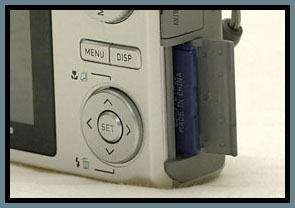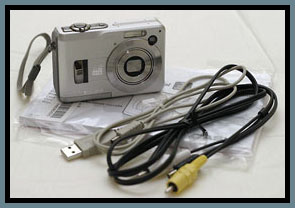
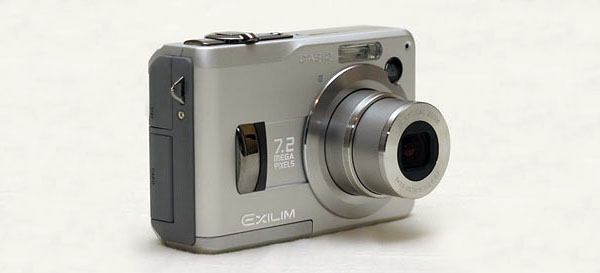 |
| Home • Reviews • Forums • News 2015 • 2013 • 2012 • 2009 • 2008 • 2007 • 2006 • 2005 • 2004 RSS Feeds • FOV Factor Table • Sensor Sizes | Definitions: A-D • E-H • I-L • M-P • Q-U • V-Z | Sitemap Articles • Archived Websites (Pre-DigitalDingus): D100 Lounge • E-10 Club | Contact |
| Casio Exilim Zoom EX-Z120 (A DigitalDingus Member Review by Matt Chase) |
| Introduction October 30, 2005 |
| Introduction • Operation - Camera • Operation - Menus • Operation - Playback Photo Tests • Comparison Images • Sample Photos Specifications • Conclusion
|
The Casio Exilim Z-120 digital camera is one of Casio's newest releases in the compact digital camera market. With 7.2 megapixels, a 3x optical zoom lens, 640x480 high quality movie mode, and 2" LCD screen in a small and lightweight body all for a suggested retail price of $329, this camera sounds like a winner.
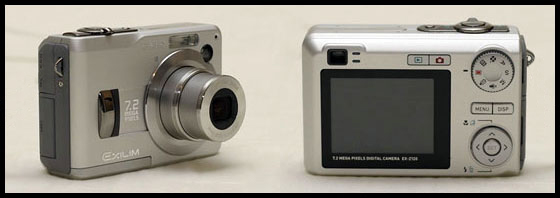 I have average size male hands and find this camera rests comfortably in one hand. The front of the body has a protruding grip for your finger, and the back has enough space to the right of the LCD to place your thumb. Operating the buttons with one hand is possible, though it is more comfortable (and just feels more secure) holding the camera with my left hand while operating it with my right hand. The camera is compact but not as small as some other recent cameras, so larger hands and fingers should still be able to operate the camera without much difficulty. The controls on the back are kept to a minimum, fairly standard for a compact digital camera. Besides the shooting mode dial, there are the Menu, Display, Playback, Camera, 4 way jogger, and Set buttons. On the top of the camera are the Zoom, Shutter, and Power buttons. The camera has two ways of being powered on, the first and most common way is with the small power button on the top. You also have the option of turning the camera on and off using either the Playback or Camera buttons above the LCD screen. These buttons are also how you switch between shooting photos and playback (viewing) of your photos, and is the only way of doing that. One minor annoyance is that when you are in playback mode, you can't simply press the shutter button to return to camera mode, you have to press the camera icon. Fortunately the camera is very quick in responding to commands, and it doesn't take long to get used to using the Camera button.
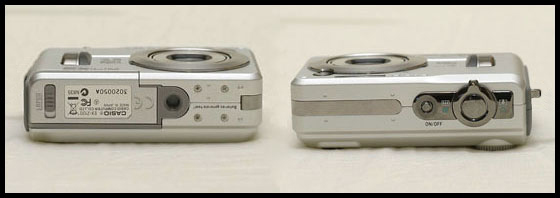 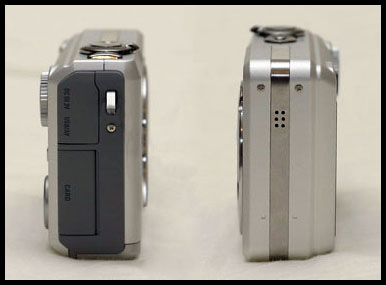 On the bottom is the tripod socket and locking battery cover. On the right side are the SD card cover, USB / AV and AC adapter plugs. I like this configuration better than other digital cameras I have used that have you insert the memory card into the same area as the battery, often on the bottom of the camera. If you are using the camera on a tripod, you will still be able to change memory cards without taking the camera off the tripod. However, if you need to change batteries you will be forced to remove the camera from the tripod for that task. On the left side of the body is the speaker for listening to recorded movies, or the audio notes that you can attach to images. The body measures 3.5"w x 2.3"h x 1"d, and including the batteries and SD memory card weighs 6.6oz.
One problem I have found with the design is with the memory card door. The card doesn't pop out very far from it's slot, and the door itself is fairly stiff so doesn't flex out of the way. This means that if you have large fingers or your fingers are a bit slick, you may have some difficulty taking the card out of the camera.
|
| Home • Reviews • Forums • News 2015 • 2013 • 2012 • 2009 • 2008 • 2007 • 2006 • 2005 • 2004 RSS Feeds • FOV Factor Table • Sensor Sizes | Definitions: A-D • E-H • I-L • M-P • Q-U • V-Z | Sitemap Articles • Archived Websites (Pre-DigitalDingus): D100 Lounge • E-10 Club | Contact |
